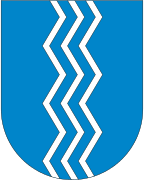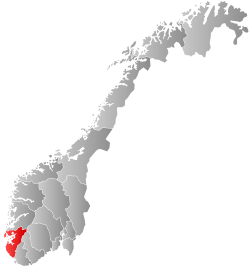Sauda
| Sauda kommune | |||
|---|---|---|---|
| Municipality | |||
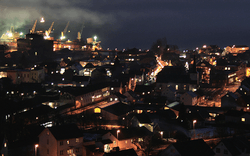 View of the town of Sauda at night | |||
| |||
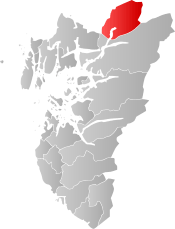 Sauda within Rogaland | |||
| Coordinates: 59°41′15″N 06°26′14″E / 59.68750°N 6.43722°ECoordinates: 59°41′15″N 06°26′14″E / 59.68750°N 6.43722°E | |||
| Country | Norway | ||
| County | Rogaland | ||
| District | Ryfylke | ||
| Administrative centre | Sauda | ||
| Government | |||
| • Mayor (2015) | Asbjørn Birkeland (Sp) | ||
| Area | |||
| • Total | 546.32 km2 (210.94 sq mi) | ||
| • Land | 507.24 km2 (195.85 sq mi) | ||
| • Water | 39.08 km2 (15.09 sq mi) | ||
| Area rank | #198 in Norway | ||
| Population (2017) | |||
| • Total | 4,760 | ||
| • Rank | #210 in Norway | ||
| • Density | 9.4/km2 (24/sq mi) | ||
| • Change (10 years) | 0.6% | ||
| Demonym(s) | Saudabu[1] | ||
| Time zone | UTC+01:00 (CET) | ||
| • Summer (DST) | UTC+02:00 (CEST) | ||
| ISO 3166 code | NO-1135 | ||
| Official language form | Nynorsk | ||
| Website |
www | ||
Sauda (![]()
The 546-square-kilometre (211 sq mi) municipality is the 198th largest by area out of the 422 municipalities in Norway. Sauda is the 210th most populous municipality in Norway with a population of 4,760. The municipality's population density is 9.4 inhabitants per square kilometre (24/sq mi) and its population has increased by 0.6% over the last decade.[3] The town of Sauda is the fifth largest town in Rogaland county with 4,254 inhabitants (2016), and the city center is home to Northern Europe's largest melting plant, Eramet Norway AS. The municipality is situated in the mountain valleys surrounding the Saudafjorden.
General information
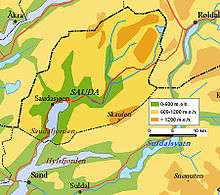
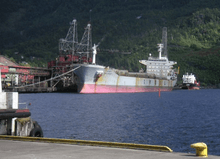
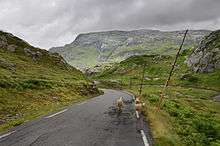
The municipality of Sauda was established in 1842 when it was separated from the large municipality of Suldal. Initially, Sauda had a population of 1,584. The municipal boundaries have never changed.[4] The municipality declared the urban area of Sauda as a town in 1999.[5]
Name
The municipality (originally the parish) is named after the old Sauda farm (Old Norse: Sauðar), since the first Sauda Church was built there. The farm is now part of the village of Saudasjøen. The name is the plural form of sauðr which means "spring" or "issue of water". Before 1918, the name was written as "Saude" or "Søvde".[6]
Coat-of-arms
The coat-of-arms was granted on 14 May 1976. The arms show three, vertical, jagged, silver/white lines on a blue background. The jagged lines symbolically represent a river as a means for hydroelectricity. Historically, power was generated by watermills, providing a possibility for the development of an industry in the village. Presently, the power is used for melting metal ore in smelters in the municipality.[7]
Churches
The Church of Norway has one parish (sokn) within the municipality of Sauda. It is part of the Ryfylke deanery in the Diocese of Stavanger.
| Parish (Sokn) | Church Name | Location of the Church | Year Built |
|---|---|---|---|
| Sauda | Sauda Church | Sauda | 1866 |
| Saudasjøen Chapel | Saudasjøen | 1973 |
History
Archaeological excavation in Saudasjøen shows that people have been living in Sauda since the latest Ice Age. In 1349, the Plague/Black Death wiped out about two-thirds of the population in Sauda, causing a decline in both population and economy. Despite this, the population was increasing during the medieval period, and a new type of industry started to grow. Along the fjord, the power from several waterfalls was used to build and run sawmills, and large-scale lumber production was started. People from all over the world, especially from the Netherlands, started to trade with the people of Sauda. This resulted in major ship traffic, giving impetus to further development of the villages and farms in Sauda.
By the end of the 19th century, a new type of adventure would change the lives of the inhabitants forever. The mining industry started in the mountains of Hellandsbygd, making Sauda a small industrial area and trading center for the surrounding region. In 1910, the American company Electric Furnace Company (EFP) began the construction of Europe’s largest smelting plant here in Sauda. This could only be done because of the large number of waterfalls and rivers that made it possible to build power plants situated a short distance from the smelter, which uses large amounts of electricity.
Sauda's time as a farming village was now over, and the people of today still live on the foundation of the new town that emerged. By the end of World War II, the Germans had finished building a large Aluminum Melting Plant in Saudasjøen, but the production was moved to Årdal in 1946. The remaining buildings were demolished by the municipality in the 1950s, leaving the industrial area in Saudasjøen empty for decades. In the 1980s, a glass production factory was established together with a couple of mechanic production factories. The population of Sauda reached its peak in the mid-1960s, approximately 6,700 inhabitants. In 1998, the urban area of Sauda was declared to be a town (mostly a symbolic name, with no new municipal authority).
Geography
Sauda is located in the valleys and mountains surrounding the Saudafjorden. Outside of the main valley, most of the municipality is very mountainous terrain, with mountains like Skaulen (1,560 metres or 5,120 feet) and Kyrkjenuten (1,620 metres or 5,310 feet). The town of Sauda is located about two hours by boat from the city of Stavanger, about three hours by car from the city of Bergen, and about five hours by car from the national capital, Oslo. The mountains surrounding the village of Saudasjøen contain one of the biggest ski resorts on the west coast of Norway. The town of Sauda is located on flat land, a delta created by the rivers that empty into the fjord just outside the town centre.
Government
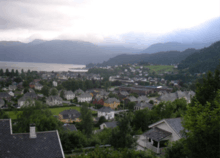
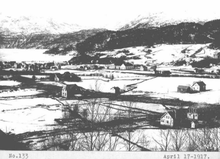
All municipalities in Norway, including Sauda, are responsible for primary education (through 10th grade), outpatient health services, senior citizen services, unemployment and other social services, zoning, economic development, and municipal roads. The municipality is governed by a municipal council of elected representatives, which in turn elect a mayor.
Municipal council
The municipal council (Kommunestyre) of Sauda is made up of 19 representatives that are elected to four year terms. Currently, the party breakdown is as follows:[8]
| Party Name | Name in Norwegian | Number of representatives | |
|---|---|---|---|
| Labour Party | Arbeiderpartiet | 5 | |
| Conservative Party | Høgre | 3 | |
| Christian Democratic Party | Kristelig Folkeparti | 1 | |
| Centre Party | Senterpartiet | 9 | |
| Socialist Left Party | Sosialistisk Venstreparti | 1 | |
| Total number of members: | 19 | ||
Economy
The main activity is industry, with large companies represented like Eramet, Saint-Gobain, Statkraft, Sauda Building Center, Statnett, Elkem, and Effektivt Renhold
Tourism
Sauda has a well-developed nightlife, which is suited for all adult ages. There are young-adult bars, as well as more mature-adult bars accessible. A movie theater, many tourist attractions, and restaurants exist as a way of relaxing after skiing. However, the most highly recommended first stop is the après-ski at Sauda Skisenter. Also notable athletes; alpine racers, and summer-winter athletes call Sauda home.
Attractions
- Rondahaugen – with views over the city and out towards Stavanger
- Sauda Church, Solbrekk Chapel, Hellandsbygd Chapel, and Saudasjøen Chapel – local churches
- Allmannajuvet – old mines with guided tour
- Sauda Smelteverk – melting plant that is still active, guided tour after appointment
- Nordag – former aluminium melting plant in Saudasjøen
- Old Graveyard in Saudasjøen – containing tombs of Russian POWs who died when building the Nordag aluminium melting plant during World War II
- Tveittunet in Saudasjøen – old refurbished estate in Saudasjøen
- Jonegarden på Hustveit – old refurbished farm and a lumber mill
- Løyning – old farm about 10 kilometers away from Sauda
- Risvoldtunet – food service, conference center, guided tour on a mini power plant
- Åbøbyen – best conserved North-American styled village area in Norway
- Honganvikfossen – a waterfall
- Svandalsfossen – a waterfall
- Jetegrytene in Åbødalen – rivers and waterfalls
- Sauda museum – collection in downtown Sauda featuring local heritage
- Industriarbeidermuseet – museum about the life of local workmen (1920s to 1950s)
- Fagerheimsaminga – exhibition of carved wooden figures in Saudahallen
- City walk – arrangement in summer time with a guided tour through the city of Sauda
- City center – during winter, heated streets are free of snow
Notable residents
- Odd Bondevik, Bishop of the Diocese of Møre in the Church of Norway
- Bjørn Eidsvåg, priest and musician
- Kjartan Fløgstad, author
- Hans Frette (1927–1989), Member of the Parliament of Norway
- Hildeborg Juvet Hugdal, sometimes called the World's Strongest Woman
- Svein Mathisen (1952–2011), Football league and national team player
- Torfinn Opheim, former mayor and member of the Parliament of Norway
- Jakob Aano, Member of the Parliament of Norway
Twin towns — sister cities
Sauda has sister city agreements with the following places:
References
- ↑ "Navn på steder og personer: Innbyggjarnamn" (in Norwegian). Språkrådet. Retrieved 2015-12-01.
- ↑ Store norske leksikon. "Sauda" (in Norwegian). Retrieved 2015-05-10.
- ↑ Statistisk sentralbyrå (2017). "Table: 06913: Population 1 January and population changes during the calendar year (M)" (in Norwegian). Retrieved 2017-11-02.
- ↑ Jukvam, Dag (1999). "Historisk oversikt over endringer i kommune- og fylkesinndelingen" (PDF) (in Norwegian). Statistisk sentralbyrå.
- ↑ Store norske leksikon. "Sauda - tettstedet" (in Norwegian). Retrieved 2015-05-11.
- ↑ Rygh, Oluf (1915). Norske gaardnavne: Stavanger amt (in Norwegian) (10 ed.). Kristiania, Norge: W. C. Fabritius & sønners bogtrikkeri. pp. 354–356.
- ↑ "Civic heraldry of Norway - Norske Kommunevåpen". Heraldry of the World. Retrieved 2015-05-11.
- ↑ "Table: 04813: Members of the local councils, by party/electoral list at the Municipal Council election (M)" (in Norwegian). Statistics Norway. 2015.
Further reading
- Obrestad, Tor (1972). Sauda! Streik!. ISBN 8205053510.
- Fløgstad, Kjartan (1990). Arbeidets lys: tungindustrien i Sauda gjennom 75 år. ISBN 8252135978.
- Berntsen, Harald (1987). 100 år med Folkets Hus. ISBN 8210030426.
External links
| Wikimedia Commons has media related to Sauda. |
| Look up Sauda in Wiktionary, the free dictionary. |

- Municipal fact sheet from Statistics Norway (in Norwegian)
